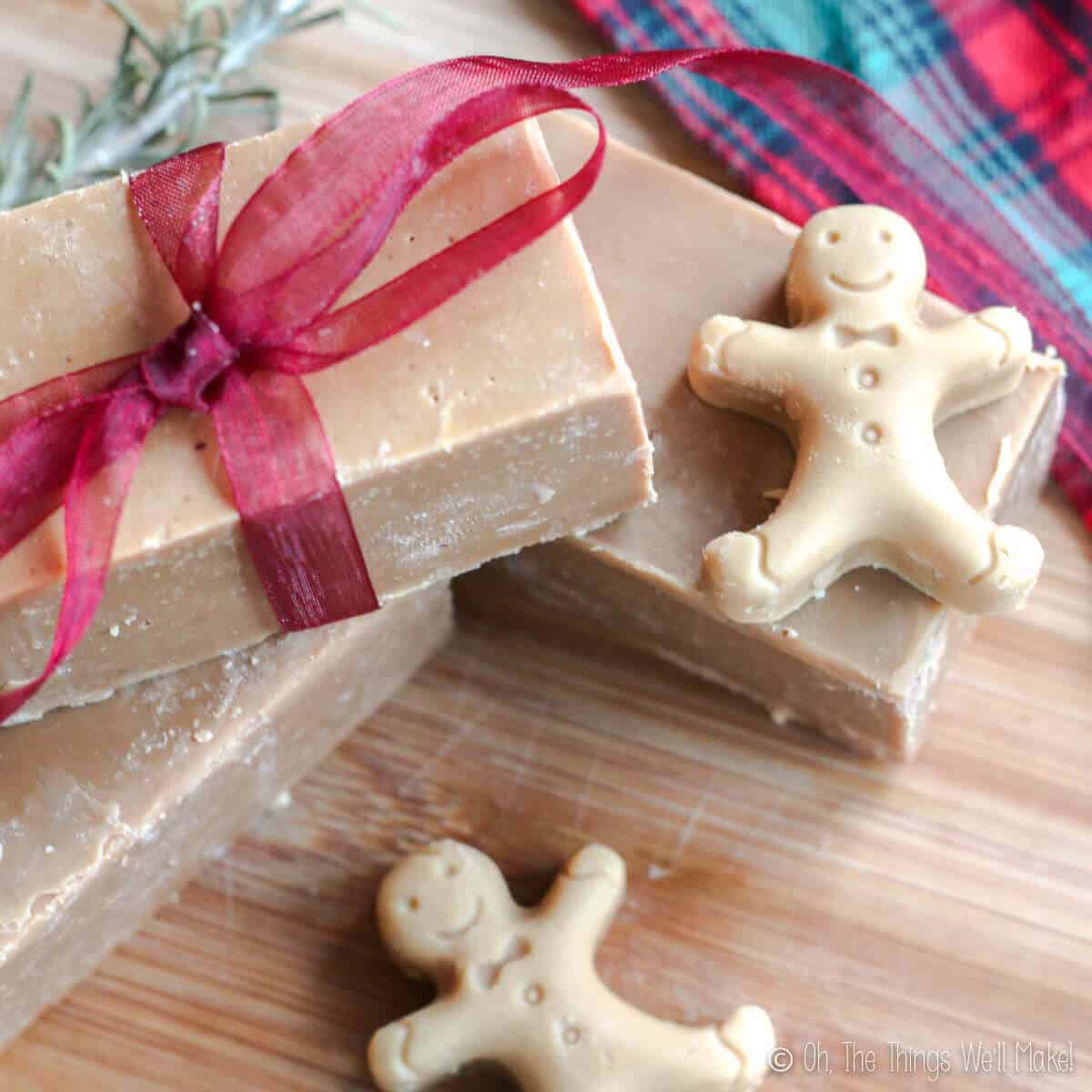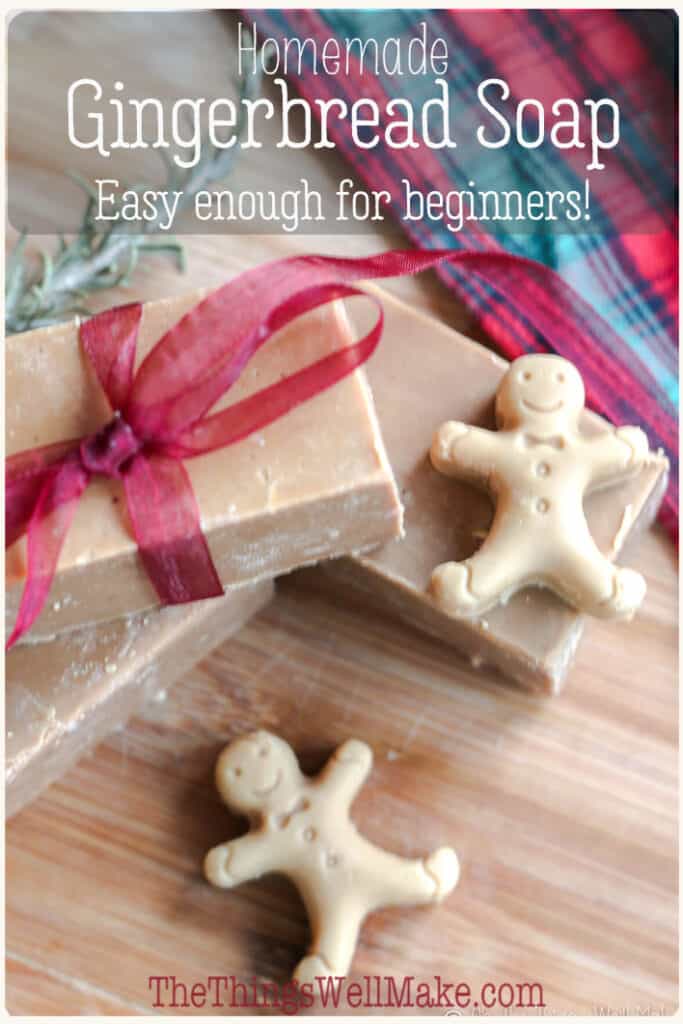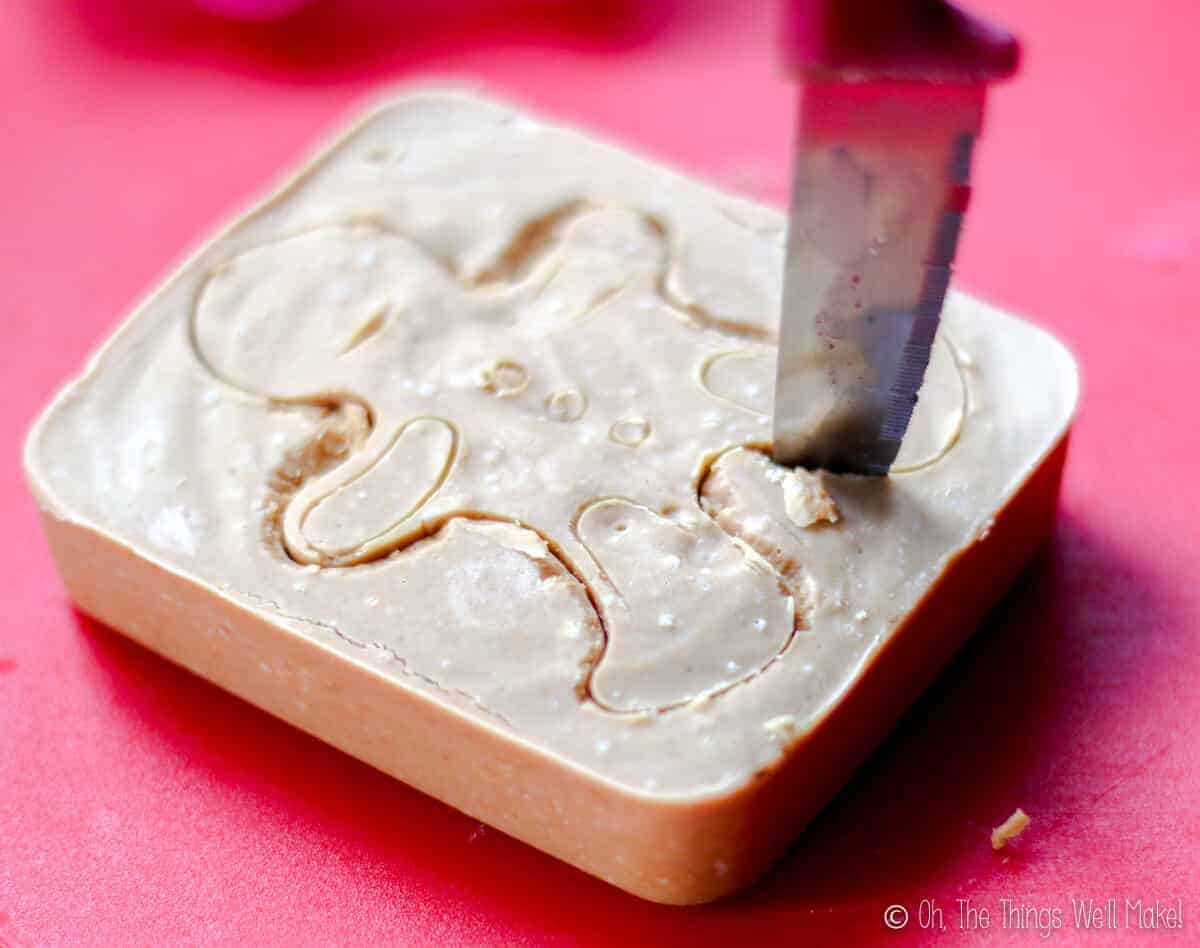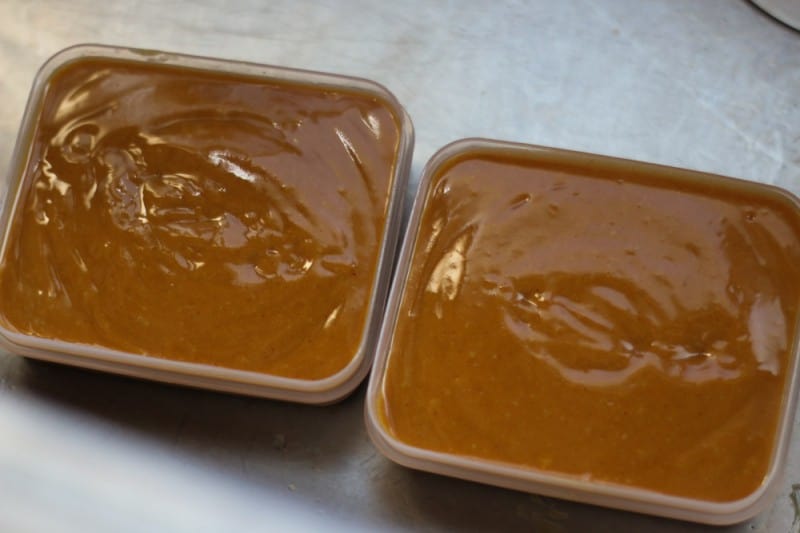The perfect stocking stuffer, this homemade gingerbread soap is easy enough for beginners to make. It has a lovely fragrance that reminds you of the holidays.

Lately, I have been having a lot of fun making new holiday soap recipes.
Christmas is the perfect time for making soap because it makes such a practical, impressive DIY gift.
Adapting the beginner soap recipe
This year, I decided to stick with something simple. I decided to adapt my easy beginner soap recipe so that you can see some of the many ways that you can adapt a recipe to suit your needs without changing out oils or needing to use a lye calculator.
You can find the basic recipe with tips for beginner soapmakers here…
Easy Basic Beginner Soap

Why and How to add Molasses
Molasses is a great addition to soap. It helps give gingerbread its characteristic taste and color, so I knew it would be important to add it to the soap. Not only did the molasses naturally give the soap a beautiful gingerbread color, but it also contributes minerals that help nourish the skin. Plus, the sugar in it helps make more lather.
At first, my easy soap wasn’t as easy as I thought. I made this when I still didn’t know a lot about the best way to add in sugars like molasses and decided to add it directly into the lye solution. The lye reacted strongly with the sugar making for a slightly explosive reaction.
The next time I chose to add the molasses during trace and it worked out much better.

Using chai tea for the lye solution
Rather than use plain distilled water, I decided to make the lye solution with chai tea instead. It’s not something that you need to do if you don’t want to. I’m not really sure how much of a difference it makes, but I wanted to show you that using teas or infusions is yet another way to customize a soap recipe.
For the gingerbread soap, I figured that using a chai tea would add a bit more color to the soap and would also add more of a spiced scent.
If using a tea, let it cool before adding the lye to it to avoid any sort of explosive reaction with the lye. (For more information about lye, check out my post about lye in soap making.)
For those looking how to make chai tea from scratch, I have a recipe up on the blog.
Bulk Chai Tea Recipe


Choosing your molds
I love using silicone molds more soap making. The soaps don’t stick to the silicone, and the flexibility of the molds makes it easier for the removal of the soaps when set. That said, plastic Tupperware-type containers also work well for the same reasons.
For this project, I made a variety of soaps. I used a silicone loaf pan for making the bars of soap.
I also filled some smaller plastic containers to around 2 cm depth to cut out some gingerbread man soaps with cookie cutters. While I think it makes a cute gift that way, I must admit that I like the practicality of a bar of soap much better. (Note that my cutter was too shallow for cutting the soap so I had to finish the cut with a knife.)
I also used some holiday silicone candy molds to make some cute, tiny soaps shaped like gingerbread men.
Gingerbread Soap Recipe

Easy Gingerbread Soap
Materials
Instructions
- Make the lye solution by pouring the lye into the chai tea or water (your choice) and stirring until the lye has completely dissolved. The solution will get very hot and will slowly cool down. As always, add your lye to your water and not the other way around!
- Let the solution slightly cool in an area where it won't be touched or knocked over by other people or pets. Meanwhile, mix together the olive oil and coconut oil.If making this soap in cold temperatures, when coconut oil is in its solid state, I recommend melting it before continuing. Some people prefer to heat their oils, but I don't find it necessary. The remaining heat from the lye solution will slightly warm up the oils. You can also now take the time to prepare your molds as needed. If using a wooden mold, line your mold with parchment paper or a silicone liner.
- When the lye solution has cleared up and isn't too hot to work with anymore, pour the lye mixture into the oil mixture and carefully stir them together. Once you have incorporated the lye solution into the oils you can begin to mix them together with a hand blender.
- When you start to reach trace, the point in the soap making process in which your mixture gets opaque and begins to look like a thin mayonnaise, add in the molasses and essential oils.
- For the essential oils, I used mostly ginger essential oil, some cinnamon, and a few drops of clove oil. I have to admit that I don't normally measure out the essential oils that I use in soaps because I prefer to use small amounts. I let my nose guide me. (I'd estimate I use around 5ml of EOs overall).
- Fully incorporate all of the ingredients, and pour them into your prepared molds.
- Set the soap aside for at least 24 hours. After 24 hours have passed, or when you can unmold the soap without it deforming, carefully unmold your soap. If you used a large mold, you can cut your soap into bars at this stage (or cut the soap with gingerbread man cookie cutters).
- Leave your soap to fully harden and cure for about a month. To help the process, leave space between each bar, and turn them over every couple of days during the first week or so.
- Enjoy your soap!
Notes
Holiday Gift Giving Tips
If you want to present this soap as a gift, consider making these easy snowflake gift pouches. They’re a simple, beautiful craft, and soaps fit in them perfectly.
Painted snowflake pouches

Looking for another holiday-themed soap you can make? Why not try your hand at making these cute peppermint soaps…
Peppermint Soap

This post was originally published on December 6, 2014. It was rewritten in December of 2019, adding clearer instructions and new ideas for gift giving.
 Español
Español












 How to Paint a Snowflake Christmas Gift Pouch
How to Paint a Snowflake Christmas Gift Pouch
Vanessa
Thanks for sharing! Does it keep long?
Tracy Ariza, DDS
Hi Vanessa,
Yes, in general, the soaps keep for a long time. I’ve had some soaps that I’ve kept for years. 😉
Suzanne
This looks so good! What a fun gift to make for friends for Christmas or to enjoy yourself!
Moksha E
Excellent post and wonderful blog, this sort of interesting posts I really like, keep it up…
Tamar
Just made this and love it! 🙂 I wanted to give it as Christmas presents, so I did hot process, adding the molasses, essential oils, and a couple teaspoons of ground ginger at the end, right before molding. I only waited a couple hours to unmold and cut. It was soft, but held its shape and cut easily. It’s got a speckled look, I think because I’ve never done hot process before and some bits got more solidified before I got the molasses in. I actually think it looks cute, but if I was looking for a more uniform look and wanted to do hot process again, I’d probably try adding the molasses after trace. 🙂 Thanks for the recipe!
Tracy Ariza
Did you ever try it out again?
Amy
If I were to use this recipe for embeds, how would I “oil” my mold? Would I just use a rubbing alcohol spritz?
Tracy Ariza
Hi Amy,
In all honesty, I don’t really think it’s necessary to “oil” the molds anymore. I used to do it all of the time because I had read to do so, but I’ve since stopped. Perhaps I should just remove that part from some of these older recipes.
I usually use silicone molds and never had sticking, but in the cases where I’ve used other types of molds, I haven’t really had issues either. For my peppermint soap, you can even see that I was able to remove the soap from a PVC tube by freezing the soap in the mold. Not only does it help solidify the soap to keep it from breaking, but it also slightly shrinks it, making it easier to unmold. I hope that helps.
Are you wanting to embed this soap in a clear one? I don’t do a lot of embeds, so I’m not sure about the process so much. I guess my peppermint soap was the same soap in one color embedded into another one and it held together fine without doing anything special.
Cassie
Hi! I love the sound of this recipe and can’t wait to make it! Do you by chance have percentages? I always size my batches to fit my rectangle mold, and I use ounces. Thank you!
Tracy Ariza
Hi Cassie,
I’m not sure what you mean by percentages.
I have since added the conversions to ounces for you. If you click on the “convert units” link under the ingredients, you can switch to ounces.
Victoria
Hey! I’m going to try to make this and am wondering how many grams is 150 ml of water/tea? I don’t have a measuring tool that measured mL
Tracy Ariza
Hi Victoria,
For water, it’s a one to one conversion!
So, you’d need 150g for 150 ml. 🙂
I’ll have to update the recipe with that!
Teri
I made this (and the pumpkin spice soap) today and have had some weird results. My lye/tea mixture went gel-like as it cooled, I have never had that happen before and I’ve made many batches of soap. All my bowls were clean. I added it to my oils anyway to see if it would still work and it seemed to, then once I added my eo’s and molasses the whole mixture pretty much instantly went solid. I had to dig it out in chunks from my bowl. I had a similar result with the pumpkin soap, but my lye/milk/water mix was fine. There was no time to mix the spices into 1/2 of the soap, again it started to harden right in my bowl. I managed to get it into my mold a bit easier than the gingerbread but it was still chunky. Both times trace happened quite quickly, which I realized you said might happen because of the clove oil, but I feel like something else has definitely gone wrong. Any advice would be greatly appreciated ????
Tracy Ariza
Hi Teri,
That really surprises me as these soaps both had a very long working time for me because of the large amount of olive oil in the recipe. Even with the essential oils, it really took a relatively long time for the soaps to solidify for me.
I’ve never had the gel type reaction that you had either, so I’m not really sure what happened there.
My first question is about the olive oil, maybe…
Have you made a soap with large amounts of whatever olive oil you are using before?
Soaps made with coconut oil tend to go to trace and solidify quickly. Soaps made with olive oil tend to take longer to go to trace, and give you a long working time for playing with adding spices, swirling, etc.
I’ve heard that in the US (not sure where you’re writing from), sometimes olive oil is bottled with other oils, meaning it isn’t 100% olive oil. I’m wondering if that could be an issue in this case? Obviously if the olive oil is mixed with another oil, the results and the speed of the process would be different.
I’d wait and see how the final soap turns out in any case. If it set up that quickly, you’ll probably want to cut it sooner than later too. If the soap hardens up too quickly, it will become brittle when you try to cut it if you wait too long.
You can also try melting it down with water and pouring it into the molds again. It usually doesn’t make as smooth of a soap (turns out more rustic), but may help improve the appearance if you weren’t able to get it into the molds well.
I’m thinking that there has to be some problem with one of the ingredients or the measurements somewhere- or maybe one of your essential oils is reacting in a weird way with the soap. (That doesn’t seem likely to me, though, as I’ve tried these soaps with several brands and never had issues.) I had one person tell me that they later found their problem to be a problem with the calibration of their scale. (I’m not sure what that really meant or how she fixed it, but I’m just throwing it out there as a possibility).
The other thing that could be off is the lye, but if you’ve used the same lye in other recipes and it didn’t give you any issues, then I can’t see how the lye would be problematic. Lye isn’t an ingredient that really goes bad. You used the same lye? and it’s 100% NaOH?
I’m not sure if any of that helps you, and wish I could be of more help. If you think of anything else it may be, I’m happy to give my take on it. Maybe we can work through it and figure out the problem.
Linda Daubner
I think this is a horrible recipe. The mixture seized like a volcano and I had soap all over the floor and counter. I tried to salvage it but their was too much essential oil in the recipe that the smell was not appealing. Sad to have wasted my time and all of the ingredients.
Tracy Ariza
Hi Linda,
I’m sorry this didn’t work out for you. It’s the first time I’ve heard of somebody having that sort of problem, so I’m not quite sure what went wrong. I can’t imagine how that would happen, especially not at the end of the process after the point at which you’d added all of your essential oils. By that point, you already had your soap made and were just adding in the fun ingredients that makes this a gingerbread soap.
I’d love to be able to help you. Many soaps can be salvaged by cooking them down again or doing other things to fix them depending upon what the initial issue was.
To be able to help you, though, I’d need to know exactly what happened and at what point in the recipe.
If you’d already added in the essential oils, it seems to me that the whole soap making recipe must have been fine and you had some sort of reaction when adding in the essential oils and molasses at the end of the process. Perhaps it was the type of oil you added in?
I normally say to add in essential oils by smell. (You’ll see that I did mention that in the recipe itself. I said that I use my nose to guide me when adding in the oils. If you found it getting too strong, I’m not sure why you continued to add in more oils?) It’s impossible to give a good guideline for how much oil to add in because the oils vary so much from company to company, and some oils use different parts of the same plant, giving different results. (Cinnamon is a good example where the oil sometimes says just “cinnamon” other times it says “cinnamon bark” or “cinnamon leaf.”)
In any case, it’s usually a good idea to give the soap a stronger scent than what you want in your final soap because essential oils, more than fragrance oils, tend to fade a lot during the curing process.
If you want help, feel free to contact me and I will try to help you throughout the process.
Rose Froelich
Have you made goat milk soap?
Tracy Ariza
Hi Rose,
My pumpkin spice soap uses goat milk in it, and shows you the technique of using goat milk in a soap. I’ve been meaning to make and share a honey and goat milk soap here on the blog. Perhaps I’ll have to move it up my “to-do” list. 🙂
Ilsa Monroe
You say it makes four servings. How much is one serving?
Tracy Ariza
Hi Lisa,
I’m sorry about the confusion with the servings. The recipe plugin (app) that I use to showcase recipes automatically uses “4 servings” as the generic amount of servings if you don’t write a number into the recipe. With soaps, I guess I feel it’s a bit strange to talk in “servings” because people are drawn to different sizes of bars of soap. I asked the developers of the plugin if I could remove the “servings” part for recipes where I either don’t know (older recipes that I wrote a long time ago and haven’t made in awhile so I don’t remember how many servings it made), or those that I on’t want to write in a number of servings, and they said that it just automatically defaults to 4 and there is no way to remove that number. It’s there, in a way, to allow for doubling or halving of all ingredients of a recipe, but I think it ends up just creating confusion most of the time.
For this soap, I think I can usually fill a silicone loaf pan. Since I like smaller, more rectangular bars of soap, I think I probably filled the loaf pan around halfway or a little more, and then filled a couple of small tupperware containers for different sized bars.
I hope that helps you get a sense of more or less how much soap the recipe makes, and I’m sorry for the confusion!